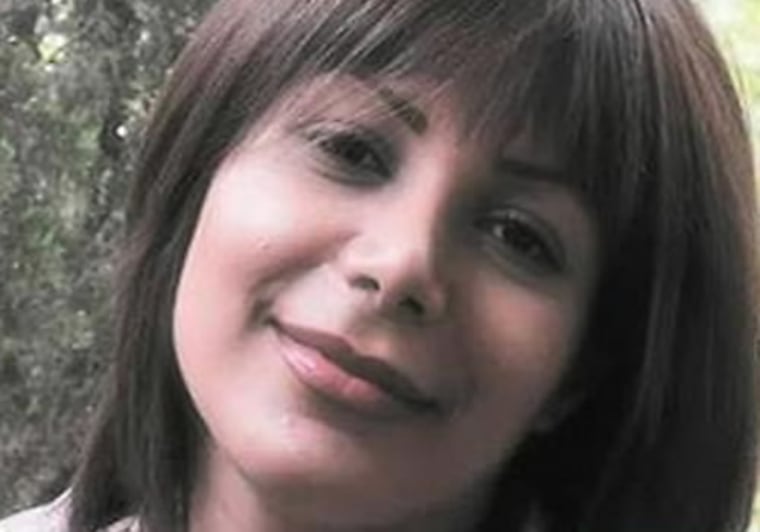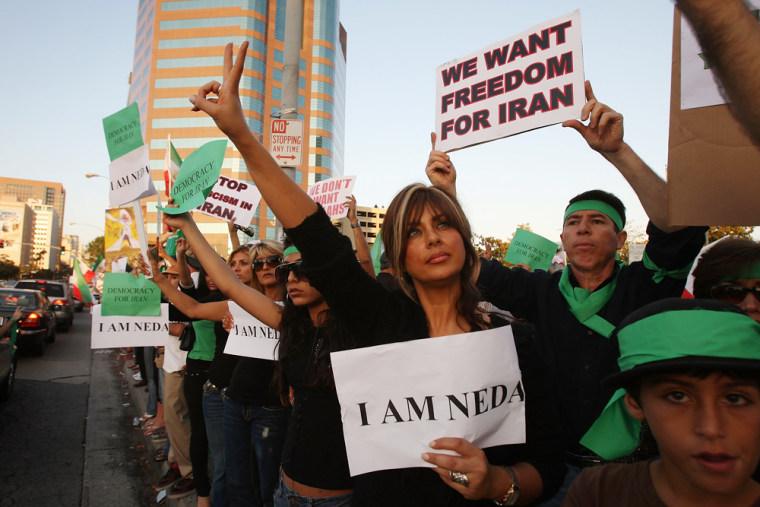She lies in the Tehran street with her headscarf half-off, blood pooling around her jeans and white sneakers.
"Don't be afraid, Neda dear, don't be afraid," a white-haired man says desperately in Persian. Another man presses on her chest, trying to keep her alive.
Scarlet blood gushes from her nose and mouth and courses across her pale face. Men and women scream in horror as they realize she is dead or dying.
The death of the woman identified as Neda Agha Soltan was captured on amateur videos and spread around the world in less than 48 hours on YouTube, Facebook, blogs and Twitter, searing the image into millions of minds. It turned the woman described as a 27-year-old music student into an instant icon of the clash between Iran's cleric-led government and the self-described "green wave" movement that claims hardline President Mahmoud Ahmadinejad stole his June 12 re-election through fraud.
The seconds-long videos also thwarted government attempts to suppress details surrounding election protests. Rules imposed last week barred independent media from street reporting and turned the people of Iran into an essential source of information on the unrest, documenting it with camera phones and e-mailing the images out to the world.
At least two recordings of Soltan's death, shot from different angles by what appear to be camera phones, began appearing widely online Saturday, the day thousands of protesters defied an order from Iran's supreme leader and marched to demand a new election. Waiting police and pro-government militia launched baton charges, tear gas and water cannons.
One of the amateur videos of Soltan is 40 seconds long, the other only 14. The person who posted the longer one says it was taken on Workers' Avenue in central Tehran.
'Freedom for all'
The woman's fiance, Caspain Makan, said she was not a firm backer of either main opposition candidate Mir Hossein Mousavi or Ahmadinejad. She simply "wanted freedom for all," he told BBC Persia in an interview.
"When the clashes were occurring, Neda was far away from the demonstrations, she was in one of the side alleys near Amir Abad," Makan said, according to a translation of the interview. "Thirsty and tired or being cooped up for about an hour in the car in heavy traffic with her music instructor, she finally gets out of the car and, based on the pictures sent in by the people, armed forces in civilian clothes and the Basiji (Iranian militia) targeted and shot her in the heart."

He said Neda died in her instructor's arms before she could be taken to a hospital.
Makan added that Basijis and mosque officials refused a request for a public memorial service.
"They knew that Neda ... died innocently, and people in Iran and the international community are informed of that fact. So they decided to avoid a situation where a mass rally would take place," he said, according to the BBC interview.
Power of social media
Protesters outside Iran have made posters of Soltan's bloodied face. Poems, tributes and angry denunciations of Iran's government have multiplied online. In some, she is compared to the lone man standing with shopping bags in his hands in front of a column of tanks in Tiananmen Square.
Videos of Soltan's death have been circulating inside Iran despite official blocking of Web sites including Facebook and jamming of satellite television signals. People have used anti-filtering software to circumvent the controls. Some Iranians have uploaded the footage to their cell phones and used Bluetooth technology to share it.
The bloody imagery could have an important impact on public opinion inside Iran, where the idea of martyrdom resonates deeply among a populace steeped in the stories and imagery of Shiite Islam, a faith founded on the idea of self-sacrifice in the cause of justice.
The deaths of protesters during the 1979 Islamic Revolution fueled a 40-day cycle of mourning marches, and shootings of mourners, that contributed to the overthrow of the U.S.-backed dictator, Shah Reza Pahlavi.
In memory of 'martyrs'
Police officials said Saturday that they had ordered officers to restrain their use of force, promising deadlier measures only if protesters returned to the streets. The government media still reported seven deaths of protesters they accused of instigating violence and rioting. It was not clear if Soltan was counted among them.
Acquaintances said she had been shot by a plainclothes member of the pro-government Basij militia, a fiercely loyal cadre that answers to the elite Revolutionary Guard and ultimately to the supreme leader. The Basij have been heavily deployed against supporters of opposition presidential candidate Mir Hossein Mousavi and blamed by protesters for much of the worst violence against them.
Persian-language postings on blogs and Twitter feeds used by supporters of the opposition called for a rally Monday at Haft-e-tir Square Tehran in memory of Neda and other "martyrs." About 200 gathered there and were quickly dispersed by riot police firing tear gas and live ammunition, quashing the demonstration and barring any further gathering of people, even in pairs, at the normally busy intersection.
